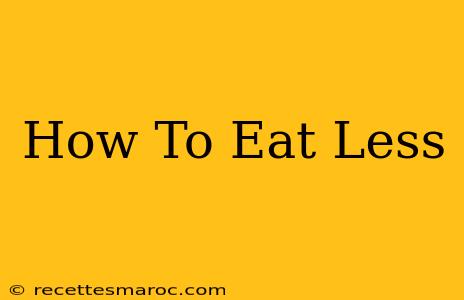Are you looking to eat less without feeling deprived? Many people struggle with portion control and finding healthy ways to manage their food intake. This comprehensive guide offers practical strategies and actionable tips to help you eat less, improve your health, and achieve your weight goals. We'll explore mindful eating techniques, dietary adjustments, and lifestyle changes that can make a significant difference.
Understanding Your Hunger Cues
Before diving into specific strategies, it's crucial to understand your body's hunger and fullness signals. Often, we eat out of habit, boredom, or emotional stress, not because our bodies genuinely need fuel. Learning to differentiate between true hunger and other triggers is a cornerstone of eating less.
Identifying True Hunger:
- A physical sensation: True hunger is a gradual, gentle feeling of emptiness in your stomach. It's not a sudden, intense craving.
- Increased energy levels after eating: When you eat to satisfy true hunger, you feel energized and satisfied afterward.
- Gradual onset: True hunger develops slowly over time.
Identifying False Hunger:
- Emotional eating: Eating to cope with stress, boredom, or sadness.
- Habitual eating: Eating at specific times regardless of hunger.
- Sensory triggers: Seeing or smelling food and automatically wanting to eat.
Practical Strategies to Eat Less
Now, let's delve into the practical steps you can take to reduce your food intake effectively:
1. Mindful Eating Practices:
- Savor each bite: Pay attention to the taste, texture, and smell of your food. Eat slowly and chew thoroughly.
- Eat without distractions: Avoid eating while watching TV, working on your computer, or scrolling through your phone. Focus solely on your meal.
- Listen to your body: Pay attention to your hunger and fullness cues. Stop eating when you feel comfortably satisfied, not stuffed.
2. Dietary Adjustments:
- Increase fiber intake: Fiber-rich foods like fruits, vegetables, and whole grains promote satiety, making you feel fuller for longer.
- Choose lean protein sources: Protein also helps you feel full and satisfied. Include lean meats, fish, beans, lentils, and tofu in your diet.
- Hydrate adequately: Sometimes, thirst is mistaken for hunger. Drink plenty of water throughout the day.
- Limit processed foods, sugary drinks, and unhealthy fats: These foods are often calorie-dense and lack nutrients, leading to overeating.
3. Portion Control Techniques:
- Use smaller plates and bowls: This creates the illusion of a larger portion, helping you feel more satisfied with less food.
- Measure your food: Use measuring cups and spoons to ensure you're eating appropriate portions.
- Pack your lunch and snacks: This gives you more control over portion sizes and ingredient choices.
4. Lifestyle Changes:
- Get enough sleep: Lack of sleep can disrupt your hormones, leading to increased hunger and cravings.
- Manage stress levels: Stress often triggers emotional eating. Find healthy ways to manage stress, such as exercise, yoga, or meditation.
- Regular physical activity: Exercise burns calories and helps regulate your appetite.
Long-Term Sustainability: It's a Journey, Not a Race!
Remember that making lasting changes to your eating habits takes time and effort. Don't get discouraged if you slip up occasionally. Focus on making gradual, sustainable changes that you can maintain long-term. Celebrate your successes and learn from your setbacks. Consider seeking support from a registered dietitian or therapist if you're struggling to make changes on your own. They can provide personalized guidance and support to help you achieve your goals.
By implementing these strategies, you can effectively learn how to eat less, improve your overall health, and reach your weight management objectives. Remember, it's about making healthy, sustainable choices for a happier and healthier you.

